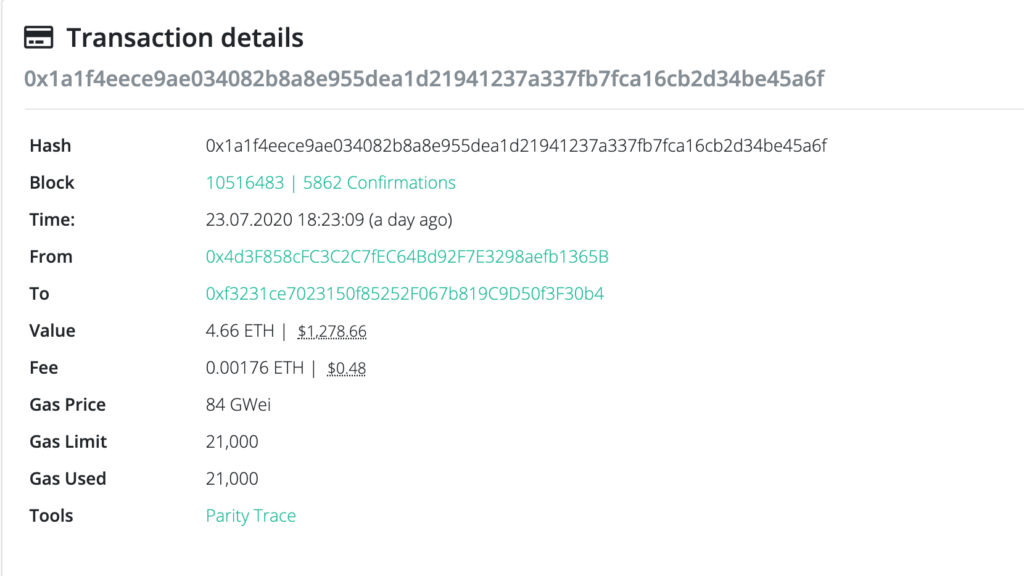Ethereum Transaction Guide

This blog post will cover:
- What is the Ethereum transaction?
- What does the Ethereum Transaction consist of?
- How to track the Ethereum transaction?
- What is the commission on the Ethereum network?
- What are Gas Limit and Gas Price?
In this article we want to explain what transactions in the Ethereum network are and how ETH transaction fees are calculated. Nowadays, the Ethereum blockchain is one of the most popular and convenient. The maximum number of transactions per month in the Ethereum network was fixed in December 2018 and amounted to 115 million. Let's see what makes Ethereum commissions different from other cryptocurrency transaction fees.
What is the Ethereum transaction?
Ethereum transaction is a sending operation of a signed data packet initiated by a network member. By operation, we mean the transfer of a certain amount of ETH, the launch of the code (program) recorded in the contract, or the creation of a new contract. The transaction is a cryptographically signed part of the instruction, which is first set by an external account, and then it is ordered and transferred to the blockchain.Any Ethereum transaction, excepting of creating new contracts, has a destination, means, a recipient. It can be an external managed account (controlled by a private key and able to send transactions) or an account contract (contains a code that is activated by the transaction). Sometimes the number of transfers increases rapidly, and the load on the network increases. This can lead to delays when transaction confirmation is delayed. There is a so-called "mempool" to keep the information about unconfirmed transactions which are waiting to be included in a block. The order of inclusion in the block depends on a number of factors, in particular, the size of the established commission, the transaction size (in bytes), the presence of a multi-signature, etc.
Let's list the basic operations that can be performed on the Ethereum network:
- Creating smart contracts
- Fulfilling smart contracts
- Transferring ETH to other addresses
What does the Ethereum Transaction consist of?
Now let's look at the Ethereum transaction data set.
First of all, it's a transaction hash (tx hash) - a unique combination of numbers and letters of the Latin alphabet which is used for identification of every transaction. ETH tx hash has the following type (all ETH transaction hashes are always starting with 0x): 0x026970c869b209148d7a67d35841f073c0db84d5af4a94f652f0b5e859e470d3.
The next important thing here is the wallet (account) address which is also the combination of numbers and letters of the Latin alphabet used for identification of the recipient. A digital signature confirming the sender's intention to conduct the transaction, nonce - the number of transactions that were sent by the sender, value is the amount of ETH that the user is willing to send.
The next points are referring to commission: Gas limit - the maximum sum of Gas that must be paid per transaction, Gas price - the price set by the user per unit of Gas (we will give more detailed definitions below), Gas used - the real amount of Gas which was used to process the transaction, Transaction fee - the commission per transaction (the price is shown in ETH and USD equivalent). Input data is the field used during contract creation. Private note - an optional field in which you can specify a message for the recipient.
To process the transaction, the Ethereum blockchain requires the following conditions:
- the transaction is carried out in RPL format and contains the digital signature of the sender;
- statistics on the number of outgoing operations specified in the transaction coincides with the same data in the account;
- the amount of Gas required for the operation to transfer funds is less than or equal to the limit set by the user;
- on the sender’s balance, in addition to the dispatch amount of ETH, there are enough funds to pay advance commission fees (gas limit multiplied by the value indicated by the user).
If all these conditions are met, the transaction is recognized as valid (correct) and is accepted for processing.
How to track the Ethereum transaction?
There are a number of services (Blockchain Explorers) that allow you to enter the Ethereum blockchain and see transactions. The most popular of them are:
- Etherscan https://etherscan.io
- Etherchain https://etherchain.org
Both of them are built on the same principle as search engines that track the payment. The main difference is the interface. Users have the opportunity to get complete information on any operation. So how to track the payment? To find information about the transaction, you need to enter the payment information (cryptocurrency wallet address, TxHash - operation code, token, or block) in the search box located on the upper panel of the page.
When the search for the Ethereum transaction is complete, you will see the following data on the page:
- Block number in the network;
- The amount of Gas that was paid for the transfer;
- Additional records that were made during the operation;
- Hashes of network blocks.

All this information will help not only to find the ETH transaction, but also to make predictions about the development of the ETH network. You can see all the blocks that are currently being generated, as well as trace the amount spent on mining.
What is the commission on the Ethereum network?
The fees in Ethereum network are slightly different from traditional Bitcoin commissions. The separate unit which is called Gas is used for paying commissions. Gas is an internal calculation unit in the Ethereum network, which indicates the size of the commission for trading operations. This commission goes to miners who support the network, guarantee its protection against duplicate transactions by closing and creating blocks in the blockchain.
There are 3 types of operations where they use Gas:
- Transaction of Ethereum coins and ERC-20 tokens;
- Creating smart contracts, various programs and saving them to the blockchain;
- Execution of a program or a smart contract.
The above actions are paid and the price (in GAS) depends on the complexity of the operation. Users do not own this unit and cannot accumulate it. The fee is calculated based on the GAS / ETH exchange rate for every transaction. The price of Gas is the amount of ETH that you are willing to spend on each unit of Gas. It is measured in "Gwei". “Wei” is the smallest unit of Ether, 1 Ether = 1018 Wei. One Gwei is equal to 109 Wei.
What are Gas Limit and Gas Price?
Gas Limit - the maximum amount of Gas that you can pay when conducting a transaction or performing any operation cycle. Remember that the standard Gas Limit for one ETH transfer to another address is 21,000 Gas! Means, if you use the Ethereum wallet only for payments - this parameter will always remain unchanged.Gas Price is the cost of one Gas unit, counted in Gwei. There are convenient services on which this calculation is performed automatically. For example, one of them is https://ethgasstation.info. From there you can calculate transaction cost. Just choose Gas Limit and preferable Gas Price. You can check several prices and see how much you will pay for the transaction and how many seconds you should wait for the transaction confirmation.The calculation of the commission is very simple. The maximum Gas Limit (Gas Limit = 21000) is multiplied by its cost (for example, 20 Gwei). We get a simple calculation: 21000 x 20 = 0.00042 ETH. This calculation is tied to the maximum amount of the commission. In reality, the service may cost less, then the rest of the payment will be credited back to the sender’s wallet. If the user wanted to save money and indicated a too small fee, then the confirmation of the operation may not occur, so the amount that was sent (but not the commission) will be returned to the user.
Remember that the speed of the transaction depends on the Gas Price, not the Gas Limit. The Gas Limit is needed to make sure that you have not used up more than you wanted to pay. The final transaction fee (Gas Limit * Gas Price) does not guarantee a quick processing time if you put a very high Gas Limit. An important factor for faster processing of the transaction is the Gas Price. Please, note that there are cases when you can easily use 1 Gwei of Gas prices and a transaction will be completed in a few minutes. Although in difficult cases you often have to use 20 to 50 Gwei of Gas prices. But if it is higher, then usually, there are no reasons to rush and it is recommended to wait a bit until the situation calms down. Therefore, be careful not to spend more than you need, and if a quick check on the https://ethgasstation.info website can save you some ETH, then why not take this chance.
Thank you for your attention, you are always welcome to get Ethereum on SimpleSwap!

